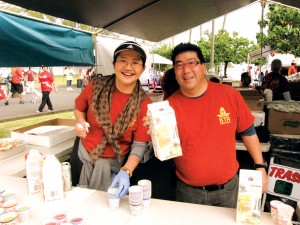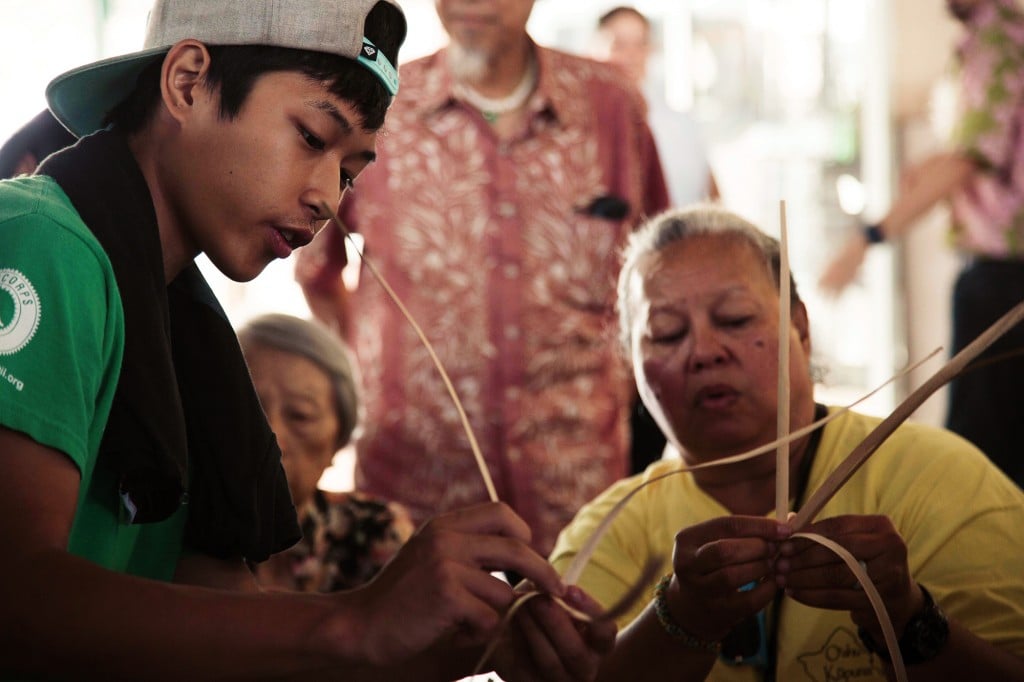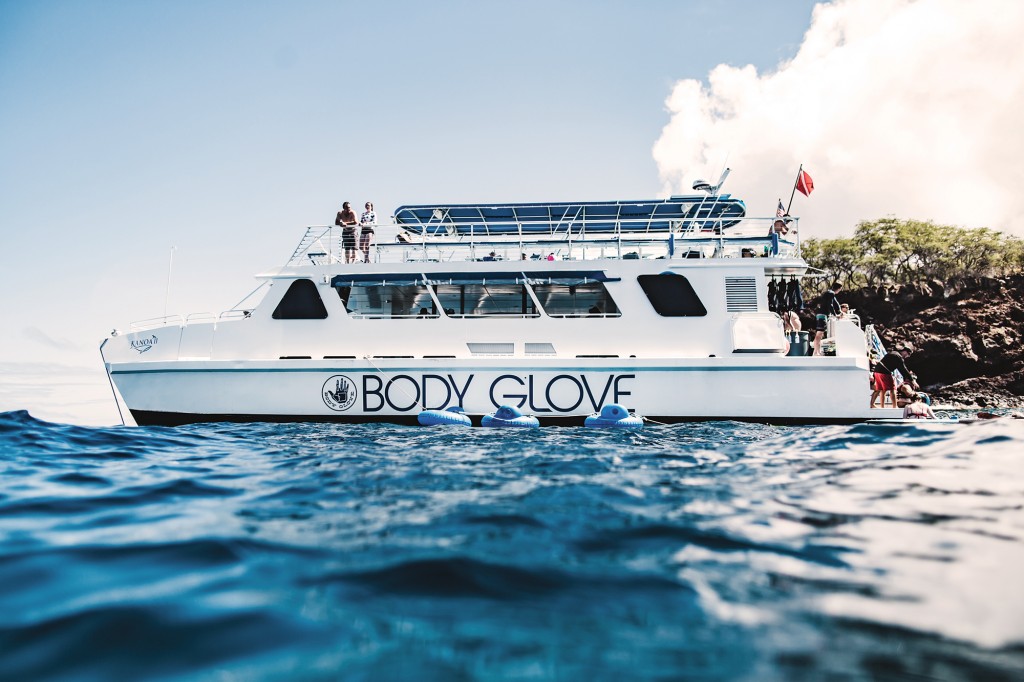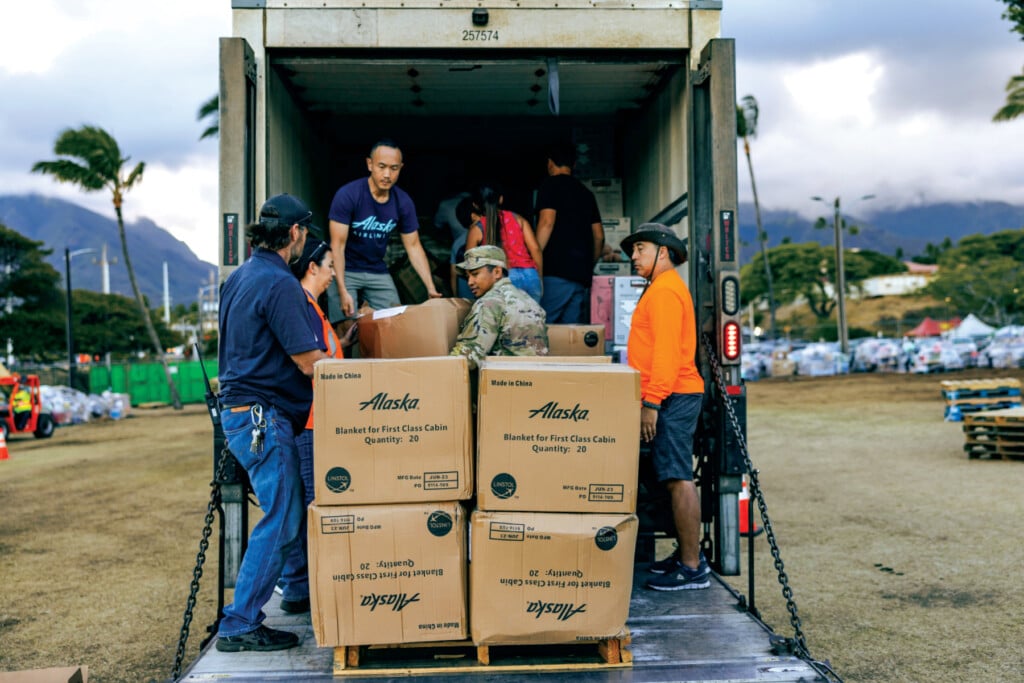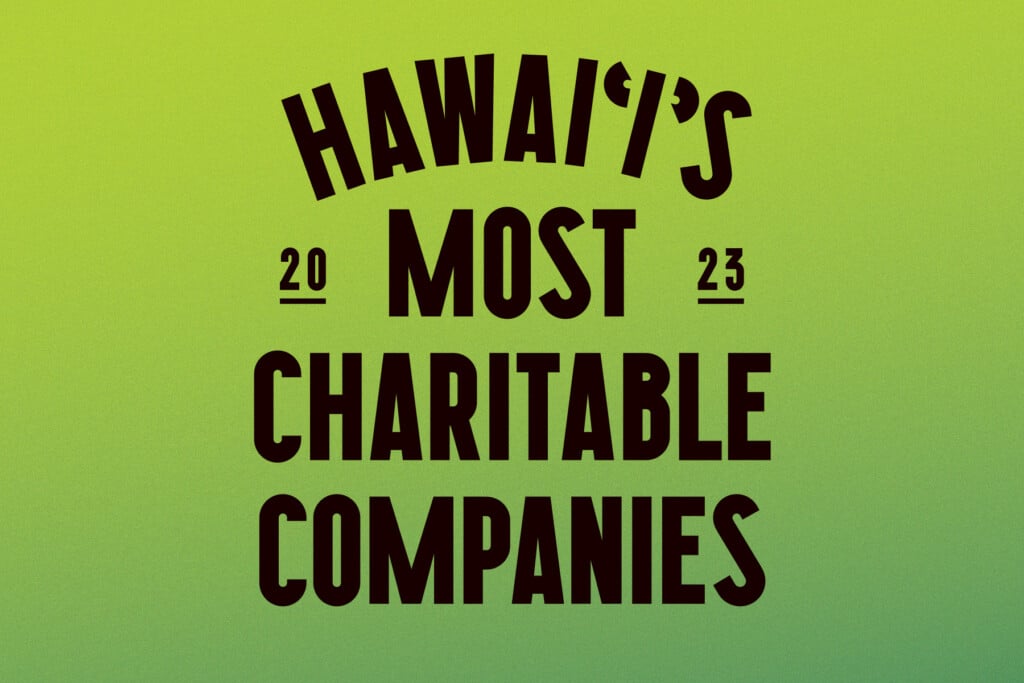The Many Ways Local Companies Give Back
76 organizations in the latest list of Hawai‘i's Most Charitable Companies gave a total of $162 million in cash and in-kind donations in 2018.
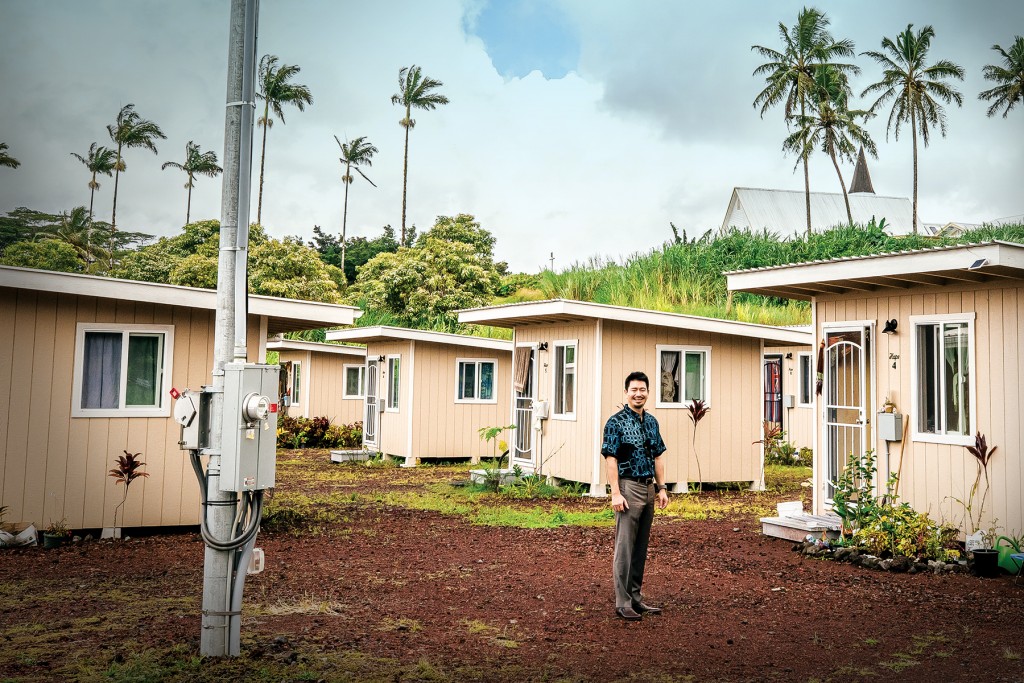
Hawaiʻi’s businesses are generous.

he 76 organizations in the latest list of Hawai‘i’s Most Charitable Companies gave a total of $162 million in cash and in-kind donations in 2018.
Those donations are essential to the survival of Hawai‘i’s nonprofits and the vital work they do. But there are other forms of giving and public service by local businesses that are harder to quantify. Hawai‘i Island-based Kaimana Jerky, for example, provides jobs to ex-convicts and former substance abusers. Both Princeville Ranch on Kaua‘i and Surfing Goat Dairy on Maui teach students about agriculture to inspire the next generation of farmers. KTA Super Stores executives and employees serve meals to the homeless, assist at United Way events, work at the local food bank and mentor foster children in their Hawai‘i Island communities.
“It’s not just a matter of, ‘I gave at the office and I’m good to go.’ No, what we see is that people who get involved get attached to and become part of the movement, and part of the ideology of the organizations. It’s where the rubber meets the road. It’s walking the talk,” says KTA President and COO Toby Taniguchi.

Hawai‘i Island Employees of KTA Super Stores raise money for the American Heart Association. | Photos courtesy of KTA Super Stores
“We can write checks too. But because we were born and raised here, we have this affinity to being part of the community that we live, work and play in.”
Local businesses also give back through their everyday practices. These can include reducing their impact on the environment, creating products that serve a social good or providing meaningful jobs, says John Leong, CEO of Kupu, a nonprofit focused on youth empowerment through environmental stewardship.
“It’s not just about the profit margin that businesses use to bless their community. It’s also about what they’re doing as a company. Giving 1% back at the end of the day is nominal compared to the other impacts the businesses have,” he says.
“I would say there’s this shared values approach that’s healthy for the world around us. And that’s just as meaningful or more so than the donation.”
Local companies practice philanthropy in expansive ways. The impact these activities have can outweigh what the businesses are able to donate. In this piece, Hawai‘i’s leaders shed light on what giving back looks like beyond the donation check.
They Invest in Being Rooted
In this year’s Most Charitable Companies survey, donations increased 12% but volunteer time increased by almost 45,000 hours, “Giving used to be confined to only a certain group of people who had the financial wherewithal to give,” says Debbie Nakanelua-Richards, Hawaiian Airlines director of government and community relations. “We still give in the traditional way of airline tickets and miles, but now we also empower our employees to choose how they want to give their time and energy. Maybe one day we’ll run out of money. But what we won’t run out of is this desire and the need to give of ourselves.”
The Hawaiian Airlines Team Kokua Program was launched six years ago to meet employees’ desires to be directly involved in shaping corporate philanthropy. Cross-functional employee teams meet regularly and decide on the volunteer programs to support, whether it’s beach cleanups or delivering food to the elderly.
“Our employees are in their communities and neighborhoods and they know better than anyone else what matters the most,” says Ann Botticelli, Hawaiian Airlines’ senior VP for corporate communications and public affairs.
“What we’re doing is fostering connection to community. To me, that’s very rich. These become relationships that are long lasting. These become points of contact where community members can say, ‘I have a need, and I know who I can call.’ It’s a way to create a more personal connection with an entity that might seem big and forbidding,” says Botticelli.
Nurturing deep roots within the community has also shaped how HPM Building Supply gives back. After Kīlauea’s lava flow destroyed hundreds of homes last year, the 98-year-old Hawai‘i Island-based company partnered with a local contractor and nonprofits to convert 20 of HPM’s outdoor sheds into microshelters. The whole process, including identifying land, lining up donations, getting the paperwork completed and organizing volunteers took just one month – a remarkably fast time, says HPM President and CEO Jason Fujimoto.
“When you are vested in your community, over time you build trusting relationships that are based on common values. Everyone knows everyone is doing things for the right reasons. So when there is an urgent need or cause, you can accelerate the process and make things work quickly. Nothing can be done solely in a silo,” says Fujimoto.
The fifth-generation company leader hopes to leverage those ties to address another of his community’s biggest challenges. HPM will soon release HalePlus, a locally made modular, expandable and transportable home. With a base model starting at less than $100,000 and a three-month timeframe from order to move-in, Fujimoto envisions this as a solution for people on Hawai‘i Island who have access to land yet can’t afford to build a home.
“The reality is, we are at a crossroads. The fact that our population has declined over two years is not a good economic indicator. We need workers, people who are vested here, to not have to move to Las Vegas or Arizona because they can’t afford to live here,” says Fujimoto.
“For us as a business here for the long term, we simply must be involved in taking action where it’s needed.”
They Invest in Job Creation
Small businesses are the backbone of Hawai‘i’s economy. But Meli James says that while there is increasing investment in Silicon Valley-style technology startups that often leave the state to grow, there isn’t the same support for companies that are committed to staying in Hawai‘i.
To fill that gap, she co-founded Mana Up, an accelerator program focused on nurturing Hawai‘i’s next 100 companies that will each eventually earn over $10 million in annual revenue. The businesses accepted into the Mana Up program typically offer products rooted in Hawai‘i, such as food, beverages or skin care made of local ingredients.
“It’s important to broaden how we feel about innovation. If you think about these amazing products here in Hawai‘i, they haven’t been able to get past the mom and pop level. They haven’t been able to get to that next zero in their revenue. Some of this is lack of resources, capital and mentorship. And a big piece has been mindset, people not believing they could grow a global brand,” says James.
By supporting local businesses, she hopes to help reverse Hawai‘i’s brain drain, luring people back from the Mainland and giving locals of diverse backgrounds the chance to not just work but to reach the upper echelons of business success. Among the Mana Up companies so far, 17 have female CEOs, 14 are run by Native Hawaiians and 13 are family businesses, says James.
“When you think about opportunities for kama‘āina or people who want to live here, how do we create a critical mass of jobs so that people can come home (to Hawai‘i), plug in and be able to jump around from job to job, like you can in most others cities?” says James.
Alice Kim and Vira Sananikone are co-founders of Hanalei, part of Mana Up’s 2018 cohort, and they are creating the kinds of jobs that locals otherwise have to go to the Mainland to find.
The Honolulu-based company creates skin-care solutions using Hawaiian botanicals such as kukui nut oil, aloe, papaya, lavender and raw cane sugar. With their products now available online as well as at the Four Seasons Ko Olina Hotel and the DFS section at the Honolulu airport, they employ 17 people in Hawai‘i, including two interns from UH.
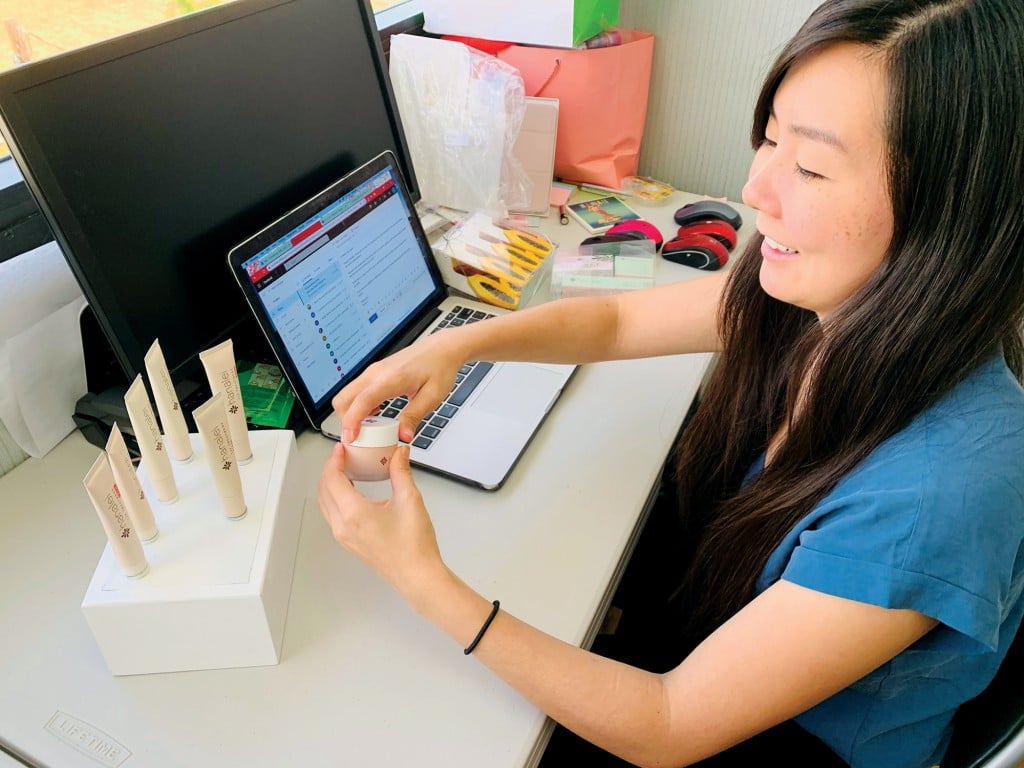
Kristen Kunimura creates product displays for Hanalei’s retail partners and for upcoming events. | Photo courtesy of Hanalei Company
“Beauty is one of those very empowering markets. But people usually have to go to LA or New York to get into this field. The majority of our staff is female, and when I talk to these Millennial women, they say that they are so glad to have the chance to work in this kind of creative environment without having to leave Hawai‘i,” says Kim.
“We have a lot of these 20-somethings leading projects and campaigns that are seen by a couple million people,” adds Sananikone. “That’s a pretty impressive opportunity for local youth just two or three years out of college.”
Offering more diverse cultural experiences for visitors and locals alike is another way to create jobs, says Kō Hana brand manager Kyle Reutner. The company’s small batch rum made of heirloom canes brings visitors to its distillery not only for tastings but for the stories behind the kō plants, the progenitors of Hawaiian sugar cane, used in a variety of rituals.
“It’s old-school American dream stuff. Get your kids an education. Work an honest job. People in Hawai‘i deserve to have all of this.”
—Kyle Reutner Brand manager, Kō Hana Rum
“We don’t own these stories. We don’t even own the cane. We just have the obligation to share these things that are in danger of getting lost,” says Reutner.
“And almost everyone who visits gets to learn about the history of Hawai‘i, and that it’s deeper than just sunshine and rainbows. That’s not to take away from sunshine and rainbows, but there’s something great about being able to go into a deeper aspect of the culture.”
Reutner says Kō Hana supports 35 jobs from management down to farming in Kunia, a part of O‘ahu that offers few opportunities.
“It’s old-school American dream stuff. Get your kids an education. Work an honest job. People in Hawai‘i deserve to have all of this. We may be out here in the middle of nowhere, but offering these jobs in Kunia is something we can bring to the table,” he says.
They Invest in the Environment
Body Glove Hawai‘i executive strategy coordinator Michael Bell grew up in Kona, snorkeling its coral reefs but also observing their deterioration due to climate change and pollution. Ten years ago, while taking customers on a snorkel tour, he realized his company had to change. As the passengers enjoyed a coffee break, the wind picked up, blowing Styrofoam cups and plastic creamer containers overboard. “That was a wake-up call. We’re making money off of the ocean and here we are letting things fall into it,” says Bell.
Today, everything the Hawai‘i Island-based business uses, from forks to trash bags to straws, is biodegradable, and all single-use plastics have been done away with, Bell says. Customers often notice, and Bell makes sure staff members are ready to talk about how their business practices affect the environment. In 2018, he says, Body Glove Hawai‘i became certified as a Kuleana Green Business by the Kona-Kohala Chamber of Commerce, and its boat is the only one in the United States certified by the Green Restaurant Association.
“It takes more effort and it’s more expensive to do it this way. But we just chalk it up to the cost of doing business. If we’re not doing it right, we don’t deserve to do it at all,” he says.
If asked to name a type of business that has not only adopted green practices but is actually improving the environment, a concrete supplier would rarely come to mind. But that’s exactly what Island Ready-Mix Concrete is setting out to do.
With the state Department of Transportation, the Kapolei-based company is using a process developed by Canadian-based CarbonCure Technologies, which injects recycled carbon dioxide into fresh concrete. Once the concrete hardens, that carbon is sequestered forever. This actually makes the concrete stronger, meaning less cement is needed. This, in turn, reduces the amount of carbon dioxide released into the atmosphere during the making of cement.
The Kapolei Interchange is the first project, says VP and GM Shorty Kuhn, and Island Ready-Mix is exploring mixes for residential homes next, with the eventual goal to provide all of its customers with concrete that benefits the environment.
“Right now people still think it’s strange and they don’t want to change what they’re doing. But I believe this will be like the penguins in Antarctica. One jumps in and they all jump in after that,” says Kuhn.
CarbonCure senior director of sustainability Christie Gamble says the efforts of local businesses like Island Ready-Mix are essential to the fight against climate change. “Concrete producers don’t wake up every day thinking about how to make their concrete more environmentally friendly. It requires a lot of initiative to take on the risks of a new innovation. But concrete producers are going to be the instrumental businesses that promote this change, pushing innovation for the further reduction of our carbon footprint.”
Most people also wouldn’t describe cattle ranching as good for the environment. But Kunoa Cattle Co. and Hawaii Meats are not following the rest of the industry, says Bobby Farias, a Kunoa co-founder now with Hawaii Meats, which operates the former ranching and processing divisions of Kunoa.
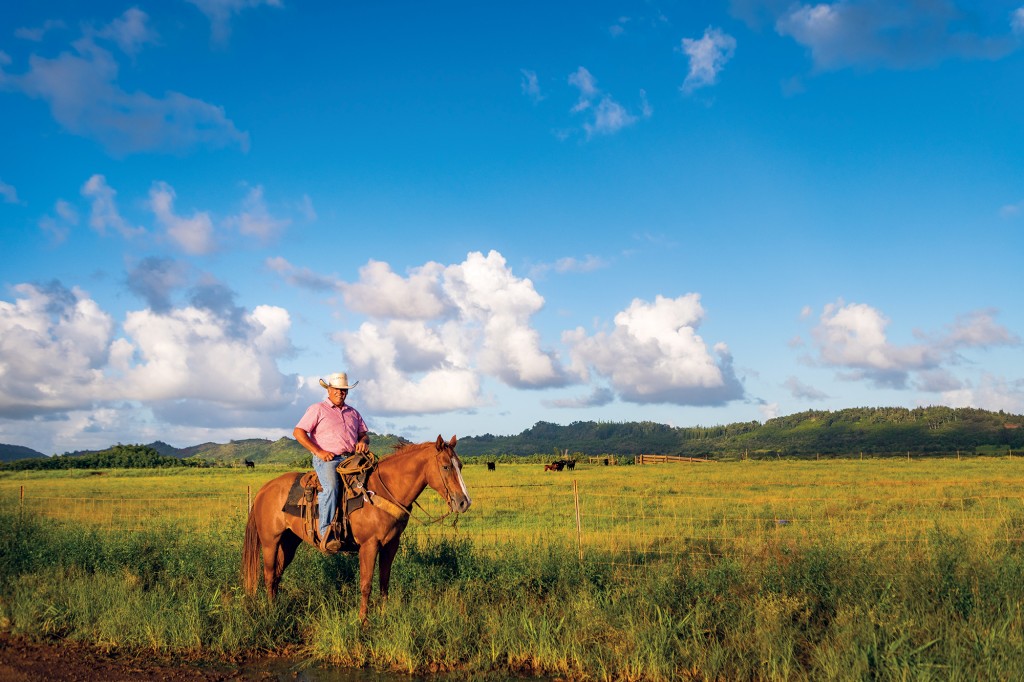
Anthony “Koni” Silva is the Kauai Ranch manager for Hawaii Meats, which with Kunoa Cattle Co. has a more sustainable model for cattle ranching. | Photo: Mallory Roe
Instead of letting cattle overgraze, which leads to soil runoff, the Kunoa and Hawaii Meats ranchers on Kaua‘i and O‘ahu regularly move cattle from acreage to acreage, raising their grass-fed beef on a diverse diet of local forages. The trampled animal waste and plant matter that results from this movement supports the regeneration of soil cultures. This, in turn, creates healthier land and stabilized soil, preventing runoff during rain and keeping our waterways and oceans cleaner, Farias says.
“If we remain local and rooted in the community, the next time something challenging happens in Hawai‘i, which it will, we’ll be rooted deeply enough to reinvest and get through that difficult period.”
—Ben Rafter, CEO of OLS Hotels & Resorts
“Our focus is on a regenerative agriculture model that mimics Mother Nature. It’s a model of holistic management. When we make a decision on the ranch, it’s not focused just on one factor. What might be best for cattle might not be best for the ground. Or what’s best for the ground might be best for the employees. We focus on holistic outcomes without having to punish anything for it. We want thriving pastures and thriving markets. And at the end of all of that is our actual health – you are what you eat.” says Farias.
For the third-generation rancher, saving the livelihood that he grew up with is about honoring his heritage and creating a more resilient future.
“A lot of our passion and tenacity comes from the fact that the ranching community in Hawai‘i refuses to give up. … Ranchers are the frontline stewards of open space in Hawai‘i. Not only is there a passion to keep the history alive, but there’s an absolute necessity to it. If we can pay our own way and grow, we can help manage fire fields, stabilize topsoils and keep open spaces open. If we want to keep the country country, we’ve got to keep the country alive,” says Farias.
They Invest in the Local Ecosystem
Ben Rafter, CEO of OLS Hotels & Resorts, says: “To give back to the community, you have to be a part of the community. You need to be vested in it. We can give time and money, which is just as important. But if you’re vested in the community you are more likely to support the products and services coming out of it.”
Renew hotel in Waikīkī, operated by OLS, reflects that commitment to being vested. It features products from local purveyors including craft coffees and teas, cold pressed juices, chocolates, whiskey, honey and skin care. But Renew, says Rafter, is also about getting people outside the hotel, where they are encouraged to participate in activities such as rebuilding ancient fishponds, restoring watersheds or removing invasive species.
Michelle Jaime, principal and director of design consultancy The Vanguard Theory, says: “We wanted to create a hotel that was going to give back to Hawai‘i, to shine a light on Hawai‘i’s culture a little deeper than you would going to a hula show and lū‘au. Those things are important, but they are things you can pick up going through Waikīkī. We wanted to do something for the conscious consumer who wants to be part of the conversation to make this place better.”
In addition to working with Rafter on the design of Renew, Jaime also collaborated with him on the Surfjack Hotel, which immerses visitors in Hawai‘i’s art and design. Pieces such as graphic artist Matthew Tapia’s hand-painted “wish you were here” illustration at the bottom of the pool, Mark Kushimi’s photos of O‘ahu’s north and south shores in the lobby, Kamea Hadar’s portrait of hula dancer Beverly Noa, and Andrew Mau’s shaka wallpaper in the restaurant aim to inspire people to get out of Waikīkī and explore the Kaka‘ako art scene.
“It’s hard to quantify what artists mean to a community. But from a qualitative point of view, having so many artists contribute is making Hawai‘i a better tourist place,” says Rafter.
Hawaiian Airlines senior VP of marketing Avi Mannis agrees that supporting the local ecosystem is an important responsibility for any company that calls Hawai‘i home. The airline spends $10 million a year on local products for its snack carts, including items from Mana Up cohort members Kunoa Cattle Co. and Hawaiian Pie Co., with plans to double that amount.
“Tourism is an important avenue for the future, but it shouldn’t be the only pillar of the economy. People focus on environmental sustainability and food sustainability. But we as a community also need to make stuff that people want to buy. We need to figure out what we as a state can produce that is differentiated and sold as something other than just a commodity. So along with the other kinds of sustainability, we also need to build a sustainable community,” says Mannis.
To nurture a sustainable community, Mattson Davis is developing a program called “farmtender,” based on the idea of an informed bartender. The former CEO of Kona Brewing Co. now owns Magics Beach Grill and to foster greater knowledge of and advocacy for the farm to table movement, each of his restaurant servers will be placed for a month at the farms, ranches and fisheries where the restaurant sources its food.
“Getting people more excited about local food makes for a thriving community.”
—Mattson Davis Owner, Magics Beach Grill
“A lot of these places don’t have much of a way to get out their information. So as a restaurant, we get to help spread their messages. We all know that we want more local produce. The way we will get it is by having people be able to understand and explain where that stuff is coming from. So when a customer asks about jackfruit, we can tell them, ‘I’ve picked it. I’ve harvested it. I’ve worked at the ‘Ulu Cooperative and this is how it’s grown,’ ” says Davis.
“Getting people more excited about local food makes for a thriving community.”
Rafter says that committing to building the local ecosystem means committing to being truly local. With a new headquarters in Honolulu, hotel chain OLS is, as Rafter puts it, owned locally by local residents and doesn’t accept private equity or institutional capital.
“It’s important to have investment from all over the world, but ultimately that money is going to private equity in the Mainland and Asia. If times became difficult in Hawai‘i, that money could go elsewhere. But if we remain local and rooted in the community, the next time something challenging happens in Hawai‘i, which it will, we’ll be rooted deeply enough to reinvest and get through that difficult period,” says Rafter.
“People who donate money – that’s vital as well. But if you’re donating time and energy, you’re still creating great things, but you’re more likely to remain part of the community. And you’re more likely to help create the ecosystems that make a community thrive.”
